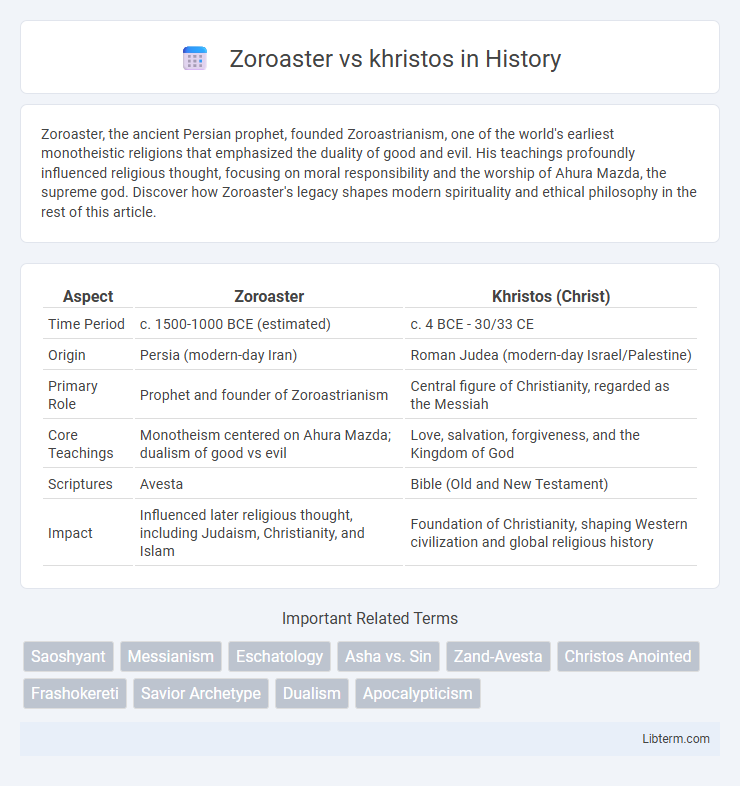Zoroaster, the ancient Persian prophet, founded Zoroastrianism, one of the world's earliest monotheistic religions that emphasized the duality of good and evil. His teachings profoundly influenced religious thought, focusing on moral responsibility and the worship of Ahura Mazda, the supreme god. Discover how Zoroaster's legacy shapes modern spirituality and ethical philosophy in the rest of this article.
Table of Comparison
| Aspect | Zoroaster | Khristos (Christ) |
|---|---|---|
| Time Period | c. 1500-1000 BCE (estimated) | c. 4 BCE - 30/33 CE |
| Origin | Persia (modern-day Iran) | Roman Judea (modern-day Israel/Palestine) |
| Primary Role | Prophet and founder of Zoroastrianism | Central figure of Christianity, regarded as the Messiah |
| Core Teachings | Monotheism centered on Ahura Mazda; dualism of good vs evil | Love, salvation, forgiveness, and the Kingdom of God |
| Scriptures | Avesta | Bible (Old and New Testament) |
| Impact | Influenced later religious thought, including Judaism, Christianity, and Islam | Foundation of Christianity, shaping Western civilization and global religious history |
Historical Background of Zoroaster and Khristos
Zoroaster, also known as Zarathustra, was an ancient Persian prophet and the founder of Zoroastrianism, which emerged around the 6th century BCE and significantly influenced religious thought with its dualistic cosmology and emphasis on moral choice. Khristos, derived from the Greek term meaning "anointed one," refers to Jesus Christ, a 1st-century CE Jewish preacher whose teachings and resurrection became the foundation of Christianity. Both figures are central to their respective religious traditions, with Zoroaster shaping early monotheistic beliefs in ancient Persia and Khristos symbolizing the fulfillment of messianic prophecies in the Roman-era Judeo-Christian context.
Origins and Early Life Stories
Zoroaster, also known as Zarathustra, emerged in ancient Persia around the 2nd millennium BCE, with early life narratives depicting his revelation of monotheism through divine Ahura Mazda encounters. Khristos, or Jesus Christ, originated in 1st-century Judea, with origins centered on a nativity story involving a virgin birth and prophetic lineage from King David. Both figures represent foundational religious founders, yet Zoroaster's origins revolve around prophetic vision and moral dualism, whereas Khristos's narrative emphasizes incarnation and salvation history.
Core Teachings and Philosophies
Zoroaster's core teachings center on the duality of good and evil, emphasizing the cosmic struggle between Ahura Mazda (the wise lord) and Angra Mainyu (the destructive spirit), advocating truth (asha), righteousness, and individual responsibility for moral choices. Khristos, representing the anointed Messiah in Christianity, teaches love, forgiveness, and salvation through faith in God and the resurrection, highlighting grace and redemption beyond strict legalism. Both figures promote ultimate moral accountability but differ in metaphysical outlooks: Zoroaster underscores ethical dualism and free will, while Khristos emphasizes divine grace and spiritual renewal.
Concepts of Good and Evil
Zoroaster introduced the dualistic concept of Good and Evil through Ahura Mazda representing truth and light, while Angra Mainyu embodies falsehood and darkness, emphasizing a cosmic battle influencing human morality and destiny. Khristos, in Christian theology, symbolizes the ultimate good through Jesus Christ as the savior who conquers sin and evil, promoting redemption, divine grace, and moral salvation. Both frameworks shape ethical principles, but Zoroaster's dualism contrasts with Khristos's triumph of good over evil through divine intervention and forgiveness.
Spiritual Practices and Rituals Compared
Zoroaster's spiritual practices center on fire rituals and the worship of Ahura Mazda, emphasizing purity, truth, and the eternal struggle between good and evil within Zoroastrianism. Khristos, in Christian tradition, focuses on sacraments such as baptism and the Eucharist, symbolizing spiritual rebirth and communion with God through Jesus Christ. Both traditions use ritual acts to align followers with higher spiritual principles but differ fundamentally in theology, symbolism, and liturgical expressions.
Influence on Later Religions
Zoroaster, the ancient Persian prophet, laid foundational concepts of monotheism and dualism that significantly influenced later religions, including Judaism, Christianity, and Islam. The moral dichotomy of good versus evil and ideas of judgment after death trace back to Zoroastrian teachings, shaping Khristos (Christ) doctrines in Christianity. Khristos introduced the concept of a messiah and salvation through faith, which redefined spiritual salvation and ethical conduct in Western religious traditions.
Messianic Prophecies and Savior Roles
Zoroaster, the ancient Persian prophet, introduced the concept of Saoshyant, a future savior destined to bring final renovation and defeat evil, aligning with Messianic prophecies in Zoroastrianism. Khristos, or Christ, in Christian theology, fulfills Old Testament Messianic prophecies as the anointed Savior who redeems humanity through his life, death, and resurrection. Both figures embody the archetype of a divine redeemer with eschatological roles centered on salvation and cosmic restoration.
Ethical Frameworks and Moral Codes
Zoroaster's ethical framework centers on the dualistic struggle between Asha (truth and order) and Druj (falsehood and chaos), emphasizing individual responsibility to promote truth, righteousness, and cosmic harmony through good thoughts, words, and deeds. Khristos, in Christian ethics, embodies unconditional love, forgiveness, and grace, advocating moral codes based on compassion, humility, and repentance to attain salvation and ethical living. Both systems emphasize moral agency and accountability but diverge in metaphysical foundations and the nature of divine-human relationships shaping ethical imperatives.
Legacy and Cultural Impact
Zoroaster, founder of Zoroastrianism, profoundly influenced religious thought through concepts like dualism and the messianic Saoshyant, shaping early Jewish, Christian, and Islamic traditions. Khristos, central to Christianity as the Messiah, catalyzed the development of Western culture, law, and ethics, establishing a global religious legacy with billions of followers. Both figures heralded transformative spiritual paradigms, embedding enduring moral and eschatological themes across diverse cultures and historical epochs.
Zoroaster vs Khristos: Lasting Relevance Today
Zoroaster, founder of Zoroastrianism, and Khristos, central figure in Christianity, represent two foundational religious paradigms shaping ethics, spirituality, and cosmology. Zoroaster's teachings emphasize the dualistic struggle between Ahura Mazda (good) and Angra Mainyu (evil), influencing concepts of moral responsibility and the afterlife still relevant in contemporary interfaith dialogues. Khristos, embodying salvation and resurrection, underpins Christian doctrines that continue to inspire billions globally, highlighting enduring themes of redemption and divine love.
Zoroaster Infographic

 libterm.com
libterm.com